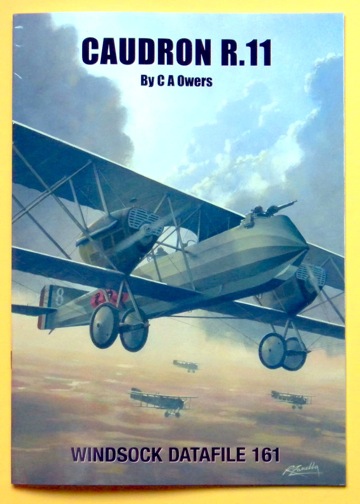Windsock Datafile No. 161 Caudron R.11
When Windsock Datafile No. 161 arrived in the mail, I was reminded of that classic Monty Python lead-in line: “And, now for something completely different” because the subject of this Datafile is a somewhat little known WWI aviation escort fighter with a most unusual appearance. Although serving with some distinction, the fact that it was introduced into the conflict in limited numbers in the closing months of the war precluded a definitive assessment of the value of the Caudron R.11, and no doubt contributed to its place somewhere in the shadows of aviation history.
The Caudron R.11 was an unusual aeronautical design to be sure, and one that, in hindsight, seems rather lanky for its intended role. Exhibiting a rather large fabric covered airframe, this twin-engined ‘fighter’ was outfitted with increased armament to provide close escort protection for French day bombers venturing to targets deep inside enemy territory. The torpedo-like fuselage of this large craft housed a crew of three, a pilot and two gunners fore and aft. But with its extended wings, the R.11’s gunners were provided a stable gun platform to fulfill their assigned responsibilities.
Following multiple favorable test flight evaluations, Caudron received orders for 1,000 R.11s, but manufacturing difficulties reduced deliveries significantly. Only 370 were built and a mere 45 were actually in French service by the armistice. However, it was reported that during the last month of the war all Breguet daylight-bombing escadrilles were accompanied by the Caudrons.
It was said that pilots liked the R.11 because it was only slightly heavier than standard two-seaters, with good performance and was more heavily armed. In fact the R.11 was further developed into the R.12, and then the R.14 with enlarged wings and modified to carry a heavy cannon. The armistice brought an end to further development and the type did not serve long after the war. However, two aircraft were shipped to the United States in 1919 for further evaluation by the US Army Air Service.
The unique Caudron R.11 deserves to be chronicled and author Colin A. Owers does a masterful job of presenting the story of the R.11 in great depth with over 60 rare photos, contemporary sketches, and eight pages of detailed 1/48 and 1/72 scale general arrangement drawings by Marty Digmayer that profile this classic type like never before. Added to all this are nine stunning new color profiles by Ronny Bar and a striking front cover painting by Roberto Zanella, which combine to make DATAFILE No.161 a valuable addition to this long-running series.
Windsock Datafile No 161 introduces the subject of the Caudron R.11 to most readers and delivers its complete story in a neatly wrapped package. Obviously it is highly recommended. My thanks to Albatros Productions and IPMS/USA for the opportunity to review this excellent publication.




Comments
Add new comment
This site is protected by reCAPTCHA and the Google Privacy Policy and Terms of Service apply.
Similar Reviews